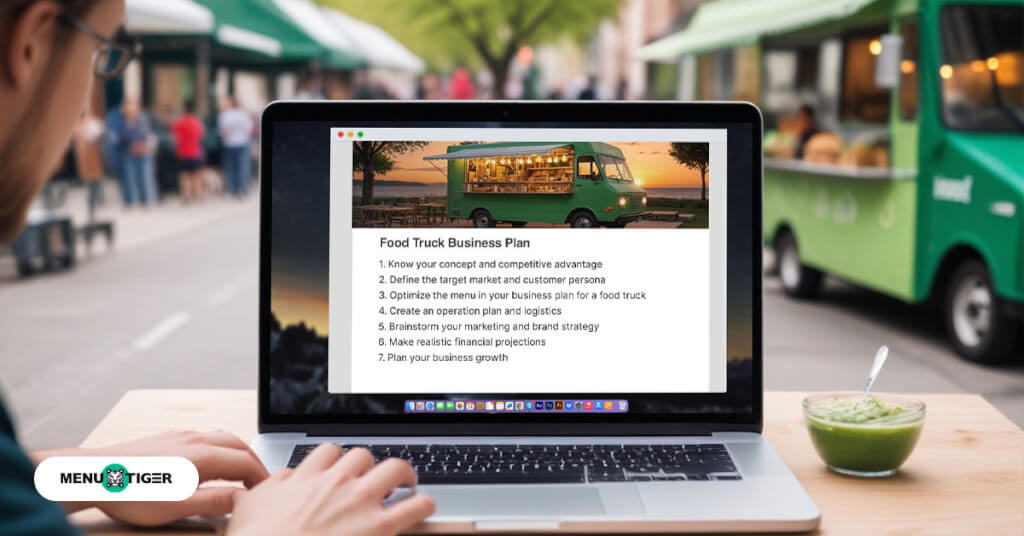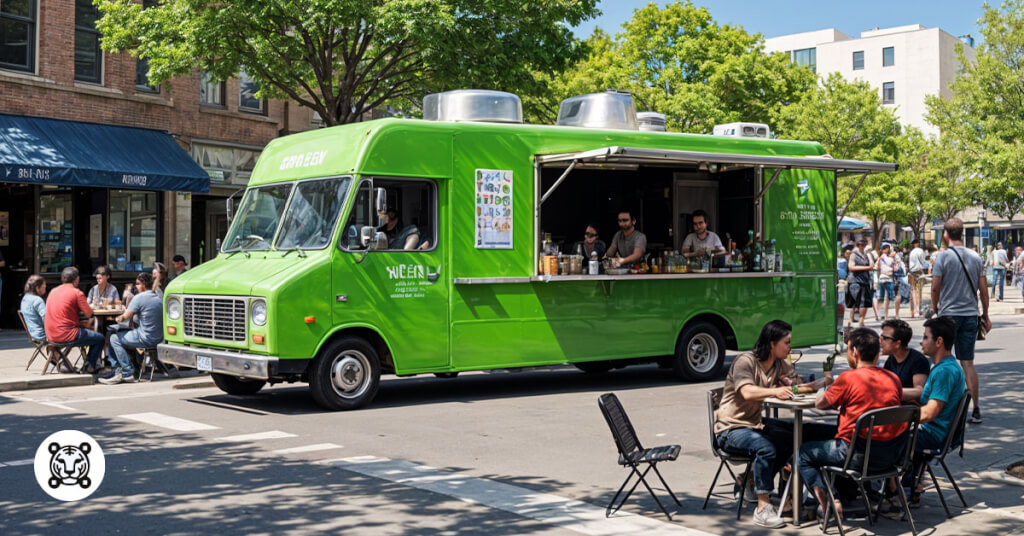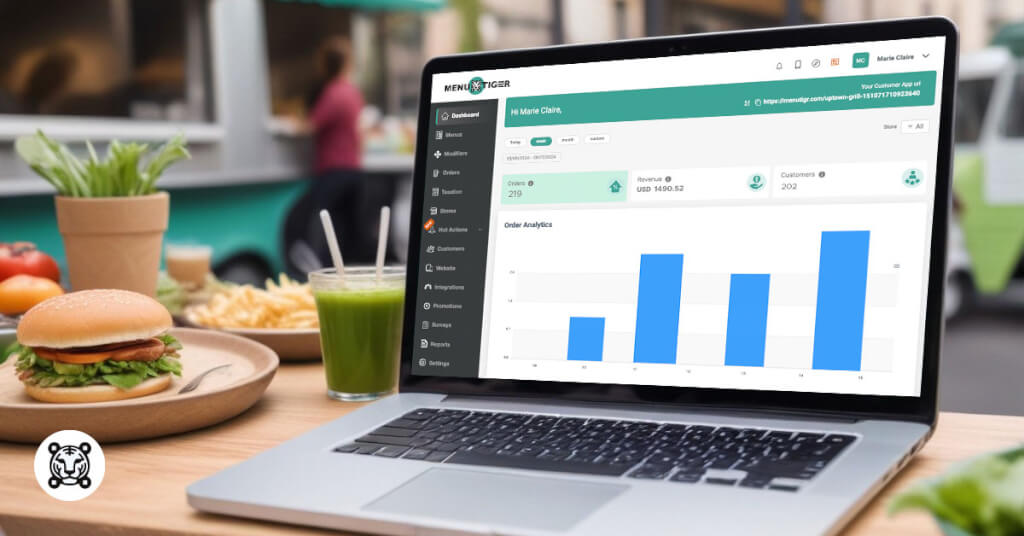
Food Truck Business Plan: A Guide For Successful Expansions
Last Updated: August 21, 2025
If you've been wondering how to start a food truck, the answer is simple: Start with a strong business plan.
Come up with your concept and competitive advantage: It could be your restructured specialty dish that can be eaten on the go, high-tech operations using interactive restaurant QR code menu software, or a unique mission to expand the business through food trucks.
If you’ve already answered these questions, then let’s get into this list of effective strategies we’ve compiled for you to begin with your business plan.
7 winning strategies for writing an effective food truck business plan
Though almost every business's plan follows the same structure, the approach to menu, service, and pricing slightly differs.
In this section, we’ll discuss these strategies, one by one, that are customized to food trucks.
Know your concept and competitive advantage
You must determine what sets you apart from your competitors.
You could use the concept of your restaurant or coffee shop. However, if you want to expand this business, it is best to start with the basics.
What distinctive cuisine or food do you want to offer? What is its flavor profile? What services will give you a competitive advantage?
Once you’ve answered these questions, conduct thorough market research to identify unmet needs and carve out a niche within the existing food truck landscape.
Don’t hesitate to get creative. Perhaps you’ll specialize in gourmet hotdogs with unique toppings or a twist on your specialty menu.
The key here is to offer something customers can’t readily find elsewhere.
Define the target market and customer persona
Develop a clear understanding of your ideal customer.
It covers demographics like age, income level, and occupation and delves deeper into buyers' buying habits and preferred locations.
Ask yourself: Are they busy professionals seeking a quick lunch option or families looking for a fun weekend outing?
This will help you make your offerings more targeted with a specific customer base.
Remember to create a detailed customer persona to make informed decisions about your menu development, marketing strategies, and overall brand identity.
What kind of food would they crave? What social media platforms do they frequently use? Where are they most likely to encounter your food truck?
Optimize the menu in your business plan for a food truck
Always prioritize efficiency and quality the same way you’ve done it in your physical outlet.
Nevertheless, design a concise menu featuring a limited number of exceptional dishes that are well-suited for a mobile environment.
Think about what can be prepared and assembled quickly without sacrificing the flavor or presentation.
In your business plan for a food truck, highlight fresh, high-quality ingredients, and consider incorporating seasonal offerings to keep your menu exciting.
Remember to factor in portion sizes and pricing. The restaurant menu pricing strategy you use in your physical store might differ from that used in a mobile kitchen.
Here, you need to balance value and profitability.
Create an operation plan and logistics

Outline your day-to-day operations, especially when you’re targeting diverse locations.
Detail food preparation procedures, equipment needs, and staff roles to ensure a smooth workflow.
Consider everything from prepping ingredients in advance to streamlining ordering and payment processes using a QR code menu or any other tools.
Observe waste management and eco-friendly practices and your compliance with the health regulations and permitting requirements for food trucks in your area.
Failing to plan for a health inspection setback could significantly disrupt your operations.
Brainstorm your marketing and brand strategy
Just like having well-planned restaurant branding and marketing in your physical restaurant, it’s equally important for you to plan one for your mobile kitchen.
Start with your social media platforms like Instagram and Facebook to showcase your offerings and establish a loyal following.
Run contests, offer promotions, and leverage eye-catching food photography to generate buzz around your community.
If you haven’t developed a website yet, create one for convenient ordering, especially for those customers who are always on the go or maybe can consider investing in restaurant mobile app development as well, to give customers a direct way to browse your menu, place orders, and stay updated on your latest locations and specials.
For practical branding ideas, don’t underestimate the impact of captivating truck signage and design that reflects your identity.
Remember, your food truck should be a rolling billboard that captures attention and reflects the deliciousness within.
Make realistic financial projections
Create realistic financial projections that account for the food truck startup costs you’ve listed, ongoing operational expenses, and ongoing revenue streams.
Add permit fees, equipment purchases, initial inventory, and recurring costs like fuel and supplies.
Also, include labor costs and potential insurance needs.
Develop a comprehensive funding strategy outlining how you plan to secure the necessary capital to launch and maintain your food truck business.
This could include personal savings, loans, or seeking investors.
Plan your business growth
Recognize that adaptation is critical to success.
Be prepared to analyze customer feedback and adapt your menu, pricing, and even locations to optimize your offerings.
Track what sells well and what doesn’t, and be willing to experiment with new dishes or items based on customer preferences and seasonal trends.
Stay informed about food trends and continuously strive to innovate and elevate your concept.
This is a good starting point if you’re thinking of franchising your concept.
Additional tips for writing a food truck business plan

Highlight your passion
While your financial projections are crucial, it’s also imperative that you showcase your passion for food that reflects the concept of your food truck.
Express great enthusiasm and knowledge in your business plan to convince investors you’re truly invested in its success.
Include a sample menu in your plan
Include sample food truck menu ideas with clear descriptions that can entice target readers.
Consider incorporating visual elements if crafting a physical document.
Having high-quality photos of your signature dishes can significantly boost the appeal of your plan.
Add the location strategy to your food truck business plan
Research and outline your permitting process for your target locations.
Knowing the legalities and potential challenges of vending in specific areas demonstrates your preparedness.
Think of making a flexible plan that allows you to adapt to different locations based on regulations and customer traffic patterns.
Decide on the technology integrations
Explore ways to leverage technology to enhance customer experience and streamline your overall operations.
You can use your restaurant ordering software (if you have one) that integrates mobile payment options or even loyalty programs through customer relationship management (CRM) systems.
Pro tip: When choosing technology to add to your food truck, don’t get overwhelmed by it, as this may get your pocket in big time. Just look for what’s functional and can serve its purpose with minimal maintenance.
Map out in the food truck business plan your competitive edge and risks
Clearly list down your your competitive advantage and how you plan to differentiate yourself in the market.
However, don’t shy away from acknowledging potential risks associated with the food truck industry, such as weather dependence or intense competition.
You should demonstrate a proactive approach to mitigate these risks through strategic planning and contingency measures.
Draft your exit strategy
While launching your food truck might be your primary focus in this business expansion, making an exit strategy demonstrates your foresight and responsibility for this business venture.
Outline potential scenarios such as selling the business or franchising, showcasing a well-rounded understanding of your long-term goals.
How to start a food truck business plan: A template

Keep in mind that there are various formats you can use when you make your business plan. This is compiled comprehensively to help you focus on the important sections.
Executive summary
Introduce here your food truck concept with a compelling tagline.
Ensure that you’re able to highlight your unique value proposition (UVP) in the first paragraph of the summary.
This is for investors or other funders to know instantly what they are investing for.
For example, if you’re launching an Asian food truck, you might want to emphasize it using authentic recipes passed down for generations.
Quantify your target market size and projected growth potential. Research the local demographics and food truck industry trends to support your claims.
Finally, summarize your financial projections, including revenue forecasts and funding requirements (if you’re seeking investment). Be clear and concise, but pique the reader’s interest with promising numbers.
Company Overview
In your overview, state your mobile kitchen’s legal name and chosen business structure (LLC or Corporation).
Explain briefly why you chose this structure based on factors like liability protection and tax implications.
You also have to have your mission statement, which defines your core purpose and commitment to delivering a superior customer experience.
Your mission statement should be concise and inspirational and can capture your food truck’s essence.
Market analysis
Provide a concise and data-driven overview of the industry, including current trends, growth projections, and relevant market research statistics.
Reference credible sources to substantiate the information gathered.
Here, you’re also going to clearly describe your ideal customer through detailed demographics (age, income, location) and psychographic interests and lifestyle.
Conduct surveys to gain deeper customer insights.
Provide a section where you can identify your direct and indirect competitors. Use a Strength, Weaknesses, Opportunities, and Threat (SWOT) analysis to assess their positioning and create a strategic advantage for your food truck.
Analyze their menus, pricing, locations, and marketing strategies to find your niche.
Products and services
Make detailed information about your offering, emphasizing the use of high-quality ingredients and innovative dishes.
When outlining your pricing approach, think about how to write quotes from suppliers to justify your costs and ensure competitive pricing for your menu items. Showcase signature items and highlight dietary considerations catered to gluten-free, vegan, and vegetarian consumers.
Using mouthwatering descriptions to entice potential customers is effective in encouraging them to pay a visit.
Also, outline your plan for sourcing ingredients from reputable suppliers.
Partner with local farmers or distributors whenever possible to control costs and promote community-focused practices in business.
Speaking of costs, justify here your pricing approach by considering competitor pricing, target market affordability, and ingredient costs.
Analyze potential profit margins while remaining competitive.
Marketing plan
Develop here a strong brand identity that can resonate with your target audience.
Include a captivating logo, a consistent color scheme, and a tagline that reflects your business's personality.
Rough out your comprehensive marketing plan, including various networks of social media for restaurants and cafes for targeted advertising and promotions.
Open business to explore partnerships with local businesses and events for better visibility to the public.

Operations plan
Detail your standard daily operations, including food preparation procedures, customer service protocols, healthy safety regulations, and efficient waste management practices.
Create a workflow that ensures efficient service that minimizes wait times.
You also need to list down the necessary food truck equipment and supplies for smoother operations, considering its durability and functionality.
Estimate costs and potential rental options, and consider obtaining financing for equipment purchases if needed.
Management organization
In this business plan template for a food truck, outline the specific roles and responsibilities of each team member, ensuring clear lines of communication and accountability.
Create an organizational chart to represent the team structure visually.
Describe your staffing needs, including the number of employees required to operate the food truck and the skill set needed.
Detail your recruitment and training strategies so that you can hire candidates who are the best fit for your business.
Financial plan
List possible costs for licensing fees, marketing materials, initial inventory, equipment, and initial working capital.
Obtain quotes from vendors to have a realistic cost estimate for every item you purchase.
For your operating expenses, forecast ongoing operational costs such as rent or permit fees for regular vending locations, food supplies, vehicle maintenance, payroll, insurance, and marketing expenses.
Project revenue based on the estimated daily or weekly customer traffic, average order value, and planned operating hours.
This way, you’ll be able to determine in your food truck financial plan whether you need to re-strategize your marketing and products.
Calculate your break-even point and the sales volume required to cover all your operational expenses. Include projected income statements, cash flow statements, and balance sheets for at least the next three years.
Growth strategy plan
If you plan to expand the business, make sure that you’ve planned out the long-term vision for growth.
Do you plan to open additional food trucks? Or offer catering services? Develop a timeline for achieving these goals.
Alongside that is building your risk management plan, where you identify potential risks that could impact your business, such as foodborne illness outbreaks, equipment breakdowns, or adverse weather conditions.
Think about having contingency plans to mitigate these risks and ensure business continuity.
Conclusion
Briefly summarize the key takeaways from your food truck business plan, reiterating your unique selling proposition and growth potential.
Reiterate your request for funding (if applicable), highlighting how the investment will be used to achieve your business goals.
Express enthusiasm and commitment to bringing your food truck concept to life.
MENU TIGER: An interactive restaurant menu QR code software for your food truck expansion

Expanding your brick-and-mortar business to wheels could be a little challenging, considering that you need to scale down your whole kitchen while efficiently providing streamlined services.
One of the most effective ways to do that is to leverage software like MENU TIGER. With its reasonable cost to make QR code menu, you can advance your operations with the minimal costs needed.
Here are a few features to highlight:
Cloud-based POS integration
This is different from your traditional point-of-sale system where you need to have bulky equipment for it to function.
With MENU TIGER, you don’t need to worry about that because it has Loyverse integration—a mobile-friendly POS system.
It runs perfectly on your tablets or mobile phones, saving up space in your food truck.
QR code menu ordering
Streamline your ordering and payment processes using this menu QR code.
It lets your customers place their orders by scanning them on their own devices, eliminating the need for them to wait on the deck of your food truck.
E-payment options, such as PayPal and Stripe, are also provided so that customers can enjoy the food without worrying about finishing up their transactions.
Multilingual support
Since you’ll be on the road, expect the diversity of your customers, especially in a highly urbanized location.
But don’t worry because MENU TIGER’s 15-language translation options have got you covered.
Multiple store management
If you plan to open a number of food trucks, you’ll need an assistant to help.
MENU TIGER offers a solution that lets you manage multiple food trucks with a single software.
This enables you to track the performance of your branches, especially in terms of sales.
Additionally, you can synchronize your marketing strategies for promotions, deals, and discounts across all locations.

Let’s kick off your mobile kitchen business with MENU TIGER QR code menu software
To enter this congested industry, you need a well-made food truck business plan that includes all the necessary actions you need to undertake.
One of the focuses of this plan that needs your full attention is how you will be able to provide smooth service despite having a small space.
The answer to that is leveraging technology like this interactive menu restaurant QR code software—MENU TIGER.
It offers various functionalities that guarantee you the most efficient and quality service there is in the market.
All you have to do is visit the website and create an account. In a few seconds, you’ll get this whole software in your hand, ready to do the work for you.
FAQs
Chevy
Before joining MENU TIGER's Content Team, Chevy has been dabbling in literary arts for five years, specifically creative writing in a theatre company. She loves exploring her creativity through painting, photography, and contemporary dancing.


